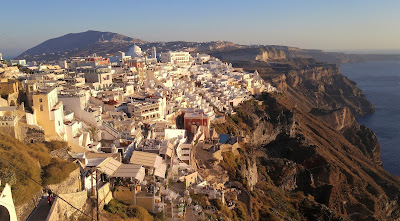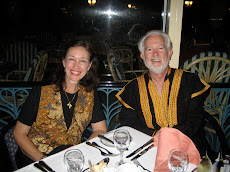 |
| City Wall of Thessaloniki |
 We departed San Antonio International Airport on Saturday 7 October, flying overnight on a very comfortable Delta jet, and landing in the morning at Athens, Greece. We were met there by our guides with Aristotle Travel and whisked to the domestic area of the airport for our short, by comparison, flight to Thessaloniki. A weary band of disciples, we were taken to our hotel for a good supper and a bed!! Touring would have to wait till tomorrow!
We departed San Antonio International Airport on Saturday 7 October, flying overnight on a very comfortable Delta jet, and landing in the morning at Athens, Greece. We were met there by our guides with Aristotle Travel and whisked to the domestic area of the airport for our short, by comparison, flight to Thessaloniki. A weary band of disciples, we were taken to our hotel for a good supper and a bed!! Touring would have to wait till tomorrow! |
| the City Wall of Thessaloniki |
 |
| Thessaloniki Harbor |
 |
| Alexander the Great |
 |
| Earthquake clock in Thessaloniki |
This clock stopped in 1978 and now only tells the exact time that a devastating earthquake shook the area causing massive destruction.
 |
| The Roman Forum in downtown Thessaloniki |
 |
| Grape clusters in a small vineyard in a churchyard |
Philippi
Near Philippi is this stream where Lydia, after her encounter with Paul and accepting Jesus as the Christ and her Savior, was baptized, along with other early believers in the area. Acts 16:11-15
 |
| Devotions at Lydia's baptism site |
Church built on the site of Lydia's home and baptism

This mosaic on the church floor highlights some of Paul's missionary journey: the names here in Greek: Philippi, Neapolis, Troas
|
 |
| Ceiling decoration within the church |
 |
| Philippi Forum |
 |
| Christogram composed of several symbols of the names of Christ |
 |
| Carving of a soldier |
with an early indoor toilet! Looks pretty cold in the winter! Apparently you could pay someone, or have a slave, sit there first to warm it up for you! 

Berea (Veria) where the Jews "received the Word with all eagerness, examining the Scriptures daily to see if these things were so." Acts 17:10-11
Meteora, not a Pauline site but a world heritage site, famous for its monasteries perched precariously atop fingerlike rock projections. Many of us got our first-ever glimpse of these in the James Bond film, "For Your Eyes Only" (click the movie name for a clip)
We spent the night at the Hotel Meteora and its marvelous Byzantine monasteries tantalizingly close!
The next day we were taken by bus along the upward winding road to two of the six monasteries.
Photos are not allowed inside, but here is a link to an excellent travel article on Meteora with more info on the monasteries and also hermitage sites there.
It's quite a steep climb! The Great Meteoran Monastery is 400 meters high and there are 136 steps to the top!

 In prior times this winch, along with its attached cable and basket, were used to bring up materials and visitors. The basket is still used for that purpose today. (except for the visitor part!)
In prior times this winch, along with its attached cable and basket, were used to bring up materials and visitors. The basket is still used for that purpose today. (except for the visitor part!)
At lunchtime we sat down on a hillside in the nearby town of Kalambaka for our picnic on the tuna lunch packs we had brought with us from home.
We proceeded to an Athens hotel, the Parthenon, for the night, after which we boarded our Greek cruise ship, the Celestyal Olympia, for the next part of the journey: the Greek islands and Ephesus.
Mykonos our first island stop with its white-washed churches and houses and its iconic windmills. It was beautiful! We walked and geocached before returning to the ship for dinner and sailing on to Kusadasi, Turkey and Ephesus.
 |
| Our ship the Celestyal Olympia at anchor |
Ephesus (click for an excellent article in Wikipedia)
 |
| The Library at Ephesus |
 |
| Ruins of the Temple of Hadrian |
The ancient theater of Ephesus where we met for a time of devotions from Ryan Horn.
 The causeway to the harbor. Wait? What harbor? Funny you should ask! This place has an interesting past in that it was built on the coast and flourished as a seaport. But the harbor began silting up, requiring the ships to stay farther and farther out. A canal was built to connect the city with the harbor, but that continued to silt up until finally the harbor had "moved too far away" and the city was abandoned.
The causeway to the harbor. Wait? What harbor? Funny you should ask! This place has an interesting past in that it was built on the coast and flourished as a seaport. But the harbor began silting up, requiring the ships to stay farther and farther out. A canal was built to connect the city with the harbor, but that continued to silt up until finally the harbor had "moved too far away" and the city was abandoned. |
| Staff of Esklepios |
 |
| Mosaic in a terraced house |
Mosaic in a terraced house in Ephesus

While walking through the ancient streets of Ephesus, I did a
(wait for it)
(wait for it)
Cat-Scan!
 |
| Roger with the Ancient Theater of Ephesus in the background |
Now, for some unusual Truth in Advertising:
 |
| no one can say he wasn't warned! |
Patmos
We sailed on to the Isle of Patmos to visit the Monastery of St John and the Cave of the Apocalypse. It was getting dark, however, and photos were not allowed at the sites. So, I've provided links that you may pursue if desired.
We paused on the way up to the monastery for Wes Bartel to lead us in a time of devotions. A look down behind Wes to the Harbor of Patmos
Crete and Knossos
We sailed next to the Greek island of Crete where the main attraction is the storied palace of Knossos, home of the fabled Minotaur. Our ship arrived in the morning and we were bussed to the palace ruins where our guide showed us through the ruins of the palace, said at one time to house the Labyrinth where the minotaur was kept. We saw neither the minotaur or his labyrinth, but the place was beautiful nonetheless!
 |
| a restored fresco of dolphins in the palace |
 |
| Fresco of young men in Knossos |
 |
| Palace Interior |
 In the port of Heraklion is this church of Sts. Peter and Paul. Built during the first period of Venetian rule by the Cistercian monks of the 12th century, and later occupied by the Dominican Order, it is one of Heraklion’s oldest architectural monuments
In the port of Heraklion is this church of Sts. Peter and Paul. Built during the first period of Venetian rule by the Cistercian monks of the 12th century, and later occupied by the Dominican Order, it is one of Heraklion’s oldest architectural monuments For a time Crete was controlled by the superpower Venice and this is a coastal Venetian fortress. Here's a link to some more info on medieval Heraklion. After lunch we sailed to the island of Santorini.
For a time Crete was controlled by the superpower Venice and this is a coastal Venetian fortress. Here's a link to some more info on medieval Heraklion. After lunch we sailed to the island of Santorini.
Santorini
This crescent-shaped island was formed by a devastating volcanic eruption in the 16th century B.C. Much of the caldera, or bowl, of the volcano is submerged , leaving the exposed parts as a ring-shaped island. It is likely that the tsunami from that eruption caused the destruction of the Palace of Knossos on Crete and, along with it, the Minoan culture.
 |
The terraced city of Fira on Santorini
|
To reach the top of the cliffs requires a cable-car ride, a donkey ride
 Or a nice LONG walk on these stairs, over 500 of them! We took the cable car ride UP, and walked back DOWN.
Or a nice LONG walk on these stairs, over 500 of them! We took the cable car ride UP, and walked back DOWN.
At the end of the day back on board our ship we were treated to a joyful folklife show of singing and dancing Greek-style.
Corinth
The next morning found us back at Piraeus, Athens' port, from where our buses took us to ancient Corinth.
 |
| Temple of Apollo |
 |
| Temple of Apollo in the background |
 |
| "Downtown" ancient Corinth |
 Our wonderful guide Dino leading us in devotions near where Paul faced the judgement seat or Bema seen below. Acts 18
Our wonderful guide Dino leading us in devotions near where Paul faced the judgement seat or Bema seen below. Acts 18  |
| Paul probably stood where our group is standing here |
 In ancient times those patients who visited a physician would bring a plaster replica of the ailing part to show the doctor where they were hurting. The small archaeological museum at Corinth has these body parts on display: probably representing a headache, arm or shoulder pain, and various leg and foot problems.
In ancient times those patients who visited a physician would bring a plaster replica of the ailing part to show the doctor where they were hurting. The small archaeological museum at Corinth has these body parts on display: probably representing a headache, arm or shoulder pain, and various leg and foot problems. |
| A beautiful mosaic in the museum |
 On our way to Kenya as missionaries in 1969, we had visited Corinth, and there we purchased our only souvenir of the trip: a painted vase modeled after those of ancient Corinth. On this trip we met the painter of our vase, Demetrius, and were able to thank him personally. A neat serendipity!
On our way to Kenya as missionaries in 1969, we had visited Corinth, and there we purchased our only souvenir of the trip: a painted vase modeled after those of ancient Corinth. On this trip we met the painter of our vase, Demetrius, and were able to thank him personally. A neat serendipity!
Athens
 |
| The Parthenon on the Acropolis |
The Acropolis, or high city, is the centerpiece of Athens and the focal point for most visitors. It is amazing! (I wish I could take credit for this beautiful picture, but it is a commercial one. The Parthenon was covered in scaffolding and not photogenic for us.)
 |
| The Erechtheion temple on the Acropolis |
 |
| The Caryatids, detail on the Erechtheion |
Mars Hill, from which Paul preached to the Athenians about their "unknown god" Acts 17:23
Ryan led us in a time of devotions here on Mars Hill; the Acropolis and Parthenon are in the background
We flew home to the USA the next day after a marvelous journey with new friends in the steps of Paul, tired but exceedingly blessed!
I cannot close this entry without given due credit to the folks on the ground that made our trip such a pleasure: the guides of Aristotle Travel! They are fellow Christian believers and their personal testimonies were a highlight! James Nikolopoulos, Konstantinos Sfikas, and the owner Dino Roussos, a graduate of Abilene Christian University. Also assisted by Fotini Kiamou and Sue Tooulas. Our inspirational devotions were led by Wes Bartel, Ryan Horn and Alton Garrison, and the entire project was coordinated by Trina Russell. Our sincere thanks to all!















































